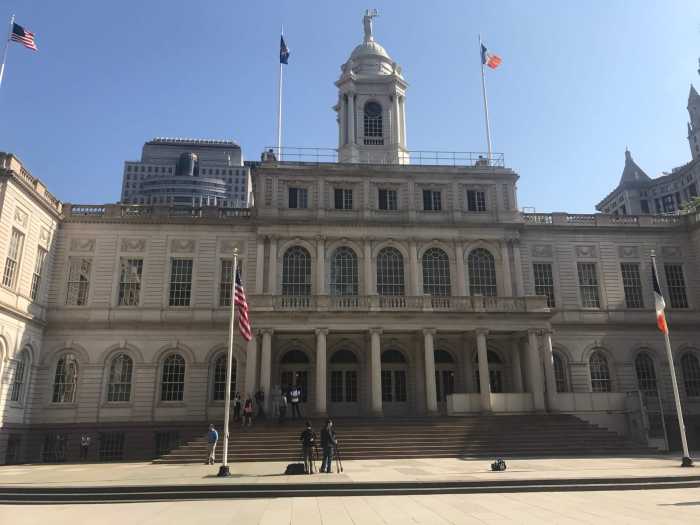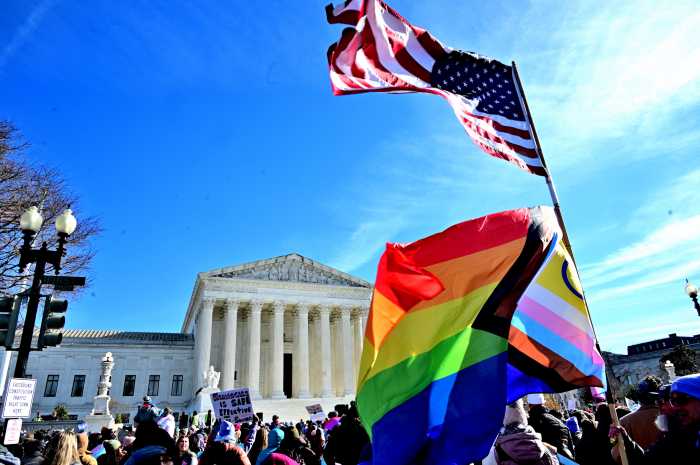“If I only get three more years on this job, there will be no child sleeping on the streets of this city for want of a shelter bed,” said Brooklyn Councilman Lew Fidler on Monday, at the second of two City Hall press conferences in five days regarding housing for homeless youth in New York.
Fidler, who faces term limits in 2009, is the chair of the Council Youth Services Committee. Advocates for homeless young people widely credit him with playing a valuable leadership role on the issue in the past several years-though of course these same voices rely on his committee to support their efforts.
But, if Fidler's vision is to be realized, the city's effort will have to increase dramatically-and in a very short time-and in the process the capacity and diversity of housing providers must also grow.
The challenges are profound and fundamental. They involve money. They relate to a population that is often invisible, beset by social ills, and widely divergent in their needs. They even implicate obstacles in simply measuring the problem.
And, not surprisingly, the challenges are particularly acute in the case of gay, lesbian, bisexual, transgendered, and questioning (LGBTQ) homeless youth.
Under Fidler's direction on Youth Services, and with strong assists from Lower Manhattan Councilman Alan Gerson and Speaker Christine Quinn, a lesbian who represents Chelsea and Hell's Kitchen, the Council has in the past several years expanded the money available for the category known as Runaway and Homeless Youth (RHY)-overseen by the Department of Youth and Community Development-from the budget baseline of $5.9 million to $8.5 million. Funds specifically related to the provision of beds rose from $3.3 million to $5.9 million.
At a press conference last Thursday with the National Gay and Lesbian Task Force and in Monday's event with a broad spectrum of youth homeless advocates, the Council laid out an ambitious commitment to tackle the problem but also acknowledged the limits of its current knowledge.
Thursday's event focused on the Task Force release of a major new policy examination of LGBT homelessness across the U.S. The study examined its causes, the social pathologies that go hand in hand with it, some examples of positive interventions, and key policy recommendations, both nationally and locally, but it began with its best estimate of the number of youths affected. According to the U.S. Department of Health and Human Services, the homeless youth population ranges between 575,000 and 1.6 million, an estimate with a variation of almost 200 percent. The National Runaway Switchboard, a federally funded operation, puts the number of homeless youths who are LGBTQ at 42 percent of that total-that is, at many as 672,000.
The estimates in New York City have little more precision. The Task Force quoted a range of 15,000 to 20,000 for the total homeless youth population, and said that, at 42 percent, the number of homeless queer youth could be as high as 8,400. Councilmembers cited numbers reaching 30,000 for the total displaced youth in the city. Several policy experts who spoke to Gay City News in late 2003 variously pegged the total between 12,000 and 20,000.
At both press conferences, Quinn zeroed in on the lack of hard data.
“It's often been said, certainly by the Bloomberg administration and others, that we can't manage and deal with what we don't measure,” the speaker said last Thursday. Developing a hard count “will make it much, much more difficult for government to ignore the problem,” she added. This week, she said better numbers “will help us, with the Bloomberg administration, to come up with a truly comprehensive plan.”
The city's Department of Homeless Services has, for several years, done a census of the city's homeless population. Teenagers and young adults living on the streets who are not part of a family, however, often go uncounted.
“Homeless youth often don't look like homeless people,” explained Margo Hirsch, executive director of the Empire State Coalition of Youth and Family Services. “There are lots of youths out at 2 in morning.”
Hirsch's group, with funding support from the Council, will complete the first formal count of homeless youth in the city during the spring of 2007, and is seeking volunteers to help in the effort. She emphasized that the drive will be spearheaded by experts in youth homelessness-including some who have experienced it firsthand-who are able to reach a population that is transient, diverse, and often unwilling to define themselves as homeless.
Hirsch's insight regarding self-definition was seconded by other experts on hand at this past week's two events. Carl Siciliano, who in 2002 founded the Ali Forney Center that houses a population of LGBT youth in emergency and transitional housing, explained that given the stigma attached to the term “homeless,” many youths living on the streets refuse to identify with it-and fortunately many, despite trauma common in their families of origin and histories that often include abuse, substance problems, and mental illness, nonetheless lack the “battered” sense of failure typically found in hardened, chronically homeless adults.
But the predisposition to reject labels can often play out simply as denial. Nicholas Ray, the author of the Task Force report, recounted the story of a young man who said he was not involved in prostitution. The youth told Ray he hooks up with older men “just to find a place to sleep for the night, not for the money. I sleep with them just to find a place to sleep for the night.”
LGBTQ youth are at disproportionate risk for homelessness because of the persistence of family and institutional homophobia, advocates say.
“They each have an adult in their life, an institution in their life that has failed them,” Hirsch said of homeless youth generally. Ray's report chronicled in detail the staggering woes facing LGBTQ kids living on the streets. Relative even to their straight homeless peers, they face greater mental health problems, substance abuse, and experience with risky sex-the last due to their need to engage in survival sex. The Task Force concluded that more than half of all homeless queer youth have attempted suicide at least once.
At institutional shelters, LGBT youth face stigma, both from straight kids and from staff. Ray told of one shelter that insisted on removing a door to a gay youth's room to prevent “inappropriate sexual activity.” Some gay teens who show up for a place to sleep are referred to conversion therapy to “cure” them of their homosexuality.
Transgendered youth face even greater burdens, the most obvious being the cluelessness of many providers as to how to house them in gender-segregated facilities. One study the Task Force identified found that transgendered homeless youth are three times more likely than gay or lesbian teens to resort to survival sex.
Faced with these myriad hurdles, homeless advocates have long understood the need to develop new housing alternatives sensitive to the realities of LGBT youth-yet even in New York such options are few and far between. Three leading providers-and at best there are only a couple of others-were on hand at the Council events: along with Ali Forney was Green Chimneys, a 50-year-old nonprofit agency that focuses all its Manhattan homeless efforts on LGBT youth, and Sylvia's Place, a facility run out of the Metropolitan Community Church/ NY in Midtown. All three providers have been beneficiaries of the new funding the Council has made available in the past two fiscal years.
Green Chimneys is the largest of the three programs. The agency houses just over 50 youths in foster care, 25 in a Grammercy Park group home, another 20 in nine transitional apartments in Harlem, where the youth learn life skills to prepare them for independent living, and six under the age of 16 in a second group home in Harlem. Two additional transitional housing programs currently house 17 other LGBT youth in scattered site apartments in Harlem; that number will soon grow to 21.
The programs have a variety of funding streams-some federal, some city-that involve different regulations in terms of on-site supervision, curfews, and more. Some of the variations in rules governing the funding appropriately respond to the differences in need presented by youth in one setting versus another. But conflicts between regulations required by different funders also create barriers to bringing more beds online and Fidler specifically pledged that the Council would focus on clearing bottlenecks as it works to expand housing opportunities.
Since it opened in 2002, Ali Forney has grown its capacity from six beds to 28, now in four locations in Manhattan and Brooklyn. In 2007, Siciliano said the organization will be able to provide 30 emergency beds and 24 in transitional apartments.
Of the three agencies, Sylvia's Place is most geared toward emergency placements. The MCC facility has a formal capacity of 20 beds, but Kate Barnhart, who manages the shelter, said youth are rarely turned away. The organization did 200 intakes last year.
“We get problematic kids, those not suitable for more structured programs,” Barnhardt said. “Forty percent tell us they have been raped.”
Explaining that it does no outreach, she said that enough youth turn up so that some sleep on counter tops just to have a roof over their heads. Siciliano said that since opening, Ali Forney has consistently had a waiting list of no less than 20 and often more than 100.
The cost of serving even the very limited numbers these three organizations can accommodate involve more than simply the 150 or so beds they have and the heat, electricity, water, and on-site supervision needed to maintain them. All three employ case managers and mental health counselors and give youth access to medical care, mental health services, meals, job placement and skills-building, planning so they can live independently, and referrals to appropriate government social services.
All that requires lots of money, and that is just one measure of the hurdles faced in replicating on a much larger scale the sort of care Green Chimneys, Ali Forney, and Sylvia's Place offer.
New York does have one Goliath in the homeless youth shelter area-Covenant House, a Catholic organization whose three emergency facilities house an average of 270 youths a night and an estimated 2,700 each year. The organization's Web site says that it provides 36 percent of the city's 179 transitional beds for men 18 to 21, 51 percent of the 189 transitional beds for young women without children, and 65 percent of the 65 transitional beds for teenaged women who have children.
But, as almost any homeless advocate will attest, Covenant House has baggage. Several homeless youth who have spoken to Gay City News in the past told of harassment and abuse they suffered or witnessed there, not only from straight residents but also from staff. The councilmembers this past week addressed the problem, even though it took press questions to get them to mention Covenant by name.
“There are anecdotal reports from many youth who said they did not feel comfortable there,” Fidler said. “That came as a huge surprise to Covenant House. I have to be fair. We are working with them. They have made a clear statement of intent to correct that problem. Now we're waiting to see if they walk the walk.”
Covenant's purported “surprise” at hearing of problems with LGBTQ youth is at odds with comments the organization made to Gay City News in 2003, when a spokesperson said it was already working to correct the situation. Covenant House did not respond to a call for comment this week.
For now, the Council is taking Covenant at its word and in the current budget has allocated nearly three-quarters of a million dollars to its programs.
“We cannot do business in this area without doing business with them,” Fidler said.
In moving forward aggressively then, LGBT homeless youth advocates face tough choices. The city's leading provider of beds has traditionally made for a hostile environment, but promises to do better, while the programs better suited to the needs of queer youth are small and ramping up that network will take significant time, effort, and resources.
Still, the successes must be noted. Theresa Nolan, who heads up Green Chimney's efforts in New York City, said that more than 57 percent of those who left its federally-funded transitional living program in its first five years had what she termed “a positive discharge”-having either completed a program designed to last roughly 18 months and train them for independent living or chosen to pursue another option. For some of those, however, the choice to leave reflected a decision that they were not yet ready for living independently. While fully one fifth moved on to independent living in which they had primary responsibility for their residence and its rent, a significant minority was expelled prior to completing the program for repeated rules violations.
Homeless youth often experience ongoing, even repeated transitions. At last Thursday's press conference, 20-year-old Angelika Santiago, a transgendered woman, talked about a job loss six weeks ago that quickly led to her becoming homeless. With what she said was “six years experience in the LGBT community,” she knew of Ali Forney, and “they set me up with a bed.” With a case manager, she has begun job placement efforts and was for the first time able to get a New York State ID card.
Yasmina Rodriguez is also 20-year-old transgendered woman, who moved to New York last December from Orlando, Florida to live with her grandmother. When her grandmother moved back to Puerto Rico earlier this year, Rodriguez “bounced around for a month” before learning of Sylvia's Place while at Generation Q, a group that serves LGBT youth in Astoria.
“This will do for now,” she explained. “Beggars can't be choosers. They have saved me basically. Without them I could have been one of the many youth who gets murdered or raped. I could have ended up as a prostitute or as a junkie.”
Rodriguez has been at Sylvia's Place for eight months, and has had her ups and downs with life in New York. On October 3, she was one of three transgendered youth arrested for using the women's room at the Port Authority Bus Terminal.
“I felt degraded and humiliated,” she told Gay City News at the time.
But this week she was celebrating her first paycheck from a Manhattan foot messenger service.
“They are very respectful,” Rodriguez said of her new employers. “They call me by my chosen name which is not my legal name. They refer to me with real pronouns. When a client says 'that gentleman,' they say, 'No, that's a lady.' They are very respectful. They actually look out for me a lot.”
For Dilo Cintron, the road has been longer and rougher. Three years ago, he told Gay City News that he had spent about six years of his youth incarcerated-in his native St. Croix, in Puerto Rico, and in New York, once on a firearms charge. A one-time Ali Forney client, he spent the last couple of years at Sylvia's Place. Now 24, and having come to grips with mental health problems, he is living on disability and, with the help of his Sylvia's Place caseworker, located a city-subsidized apartment for which his needs make him eligible.
“I am becoming a more productive person of the community,” he said. “I do a lot more. I am still readjusting myself to a more stable place. I am totally not there yet. I have been homeless for the past five years.”


































